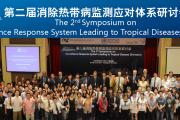The Second Symposium on Surveillance Response System Leading to Tropical Diseases Elimination has been held in Shanghai Successfully
 To establish and strengthen surveillance and response system on tropical diseases and to accelerate the global elimination process on tropical diseases, the national institute of parasitic diseases, China CDC, together with Swiss Tropical and Public Health Institute and WHO held the Second Symposium on surveillance and response system on tropical diseases elimination in Shanghai. The symposium has a special session in memory of the 140th anniversary in discovery of Clonorchis sinensis infection. Dr. Richard Cibulskis, Coordinator of WHO Global Malaria Project, Dr. Louis-Albert Tchuem Tchuente, Medical Officer of WHO Regional Office for Africa, Prof. Juerg Utzinger of Swiss Tropical and Public Health Institute, Dr. Lei Zhenglong, deputy director of National Health and Family Planning Commission, Dr. Gao Fu, deputy director of China CDC, Mr. Wang Panshi, deputy director of Shanghai Municipal Commission of Health and Family Planning, have given speech in the opening ceremony.
To establish and strengthen surveillance and response system on tropical diseases and to accelerate the global elimination process on tropical diseases, the national institute of parasitic diseases, China CDC, together with Swiss Tropical and Public Health Institute and WHO held the Second Symposium on surveillance and response system on tropical diseases elimination in Shanghai. The symposium has a special session in memory of the 140th anniversary in discovery of Clonorchis sinensis infection. Dr. Richard Cibulskis, Coordinator of WHO Global Malaria Project, Dr. Louis-Albert Tchuem Tchuente, Medical Officer of WHO Regional Office for Africa, Prof. Juerg Utzinger of Swiss Tropical and Public Health Institute, Dr. Lei Zhenglong, deputy director of National Health and Family Planning Commission, Dr. Gao Fu, deputy director of China CDC, Mr. Wang Panshi, deputy director of Shanghai Municipal Commission of Health and Family Planning, have given speech in the opening ceremony.
During the symposium, experts on tropical diseases were united to review the research progress on surveillance and response system leading to tropical disease elimination, discussed the impact of surveillance and response system on the process of eliminating tropical diseases, and explore the possibility of bilateral and multilateral cooperation aiming at tropical diseases elimination and corresponding mechanism. The experts specially discussed the construction of Sino-Africa Schistosomiasis network, malaria elimination strategies and cooperation domain in BRICS. Meanwhile, on the occasion that Clonorchis sinensis infection has been discovered for 140 years, the strategies on Clonorchis sinensis control and elimination were also discussed.
Tropical diseases are prevalence in 149 countries and regions worldwide. Every year, over 1 billion people are infected. Malaria causes 600, 000 deaths. Tropical diseases cause very heavy disease and economic burden each year. China is one of the countries which suffer heavily on tropical diseases. There is a long history of the prevalence on tropical diseases in China. Particularly in western and less developing areas, people become poor or return to poverty due to tropical diseases. In recent years, the emerging and rare tropical diseases increase significantly due to increasing population moving between countries. The World Health Assembly (WHA) proposed a road map and goal for the elimination of 10 major tropical diseases, and put the the goal in the 2012 London Declaration. China has set the goal of national malaria elimination m in the year 2012, and promised to strengthen the aid to developing countries and African countries. In 2013, in the Beijing Declaration, China also promised to establish pilot area to control and eliminate Schitosomiasis and malaria in Africa.
There were experts from 10 countries and 20 originations in the world such as universities, institutes, NGOs attending the symposium. Meanwhile, there are domestic experts from 10 universities, institutes and CDCs presented in the symposium. In the symposium, NIPD signed MOUs on long term cooperation with 4 institutes, which accelerated the establishment of tropical diseases research center. The tropical diseases research center is being established by National Health and Family Planning Committee and Shanghai government, and will be a collection of research, clinical diagnosis, disease control, information and training. Its aim is to make more impact on the elimination of tropical diseases in China and the world.
The symposium on Surveillance Response System leading to tropical diseases elimination is held every two years. The first symposium was held in Shanghai in June 2012. The prevalence situation of tropical diseases and the strategies on eliminating tropical diseases were reviewed, new strategies and methods were analyzed, the cooperation platform and resource sharing platform on strengthening tropical diseases surveillance and response mechanism were established.
